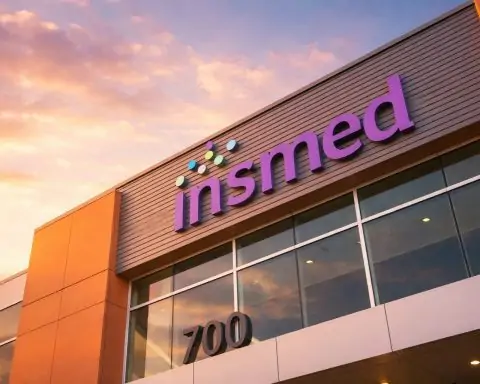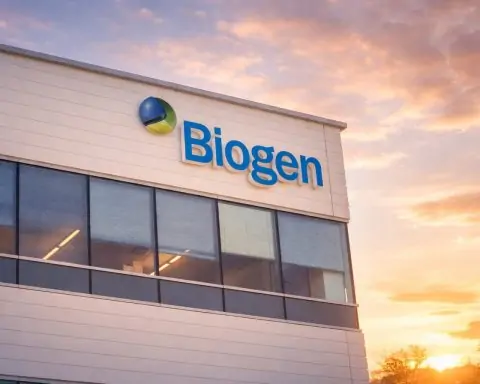Major Corporate & Industry Announcements
- CSL’s Sweeping Restructuring: Australian pharma giant CSL announced a plan to lay off up to 15% of its workforce, aiming to cut R&D costs and spin off its vaccine unit [1] [2]. The company’s earnings release outlined ~$500–550 million in annual savings (at a one-time cost of ~$700–770 million) to refocus on priority programs [3]. CSL had foreshadowed the move in July, calling for a “smaller global internal workforce” to boost efficiency [4].
- Medtronic Faces Activist Pressure: Medtech leader Medtronic struck an agreement with activist investor Elliott Investment Management, which recently took a significant stake [5]. Medtronic will expand its board with two new directors experienced in healthcare M&A and form committees to pursue cost efficiencies and “tuck-in” acquisitions [6] [7]. “Our decision to become one of Medtronic’s largest investors was driven by strong conviction… [the] company is entering a new chapter of exceptional value creation,” said Elliott partner Marc Steinberg [8], signaling optimism that streamlining and strategic deals (including a planned $2.8B diabetes unit spinout) will accelerate growth.
- Multi-Billion-Dollar Partnerships: Pharmaceutical alliances are surging. Merck KGaA and Skyhawk Therapeutics unveiled a collaboration using Skyhawk’s RNA-splicing platform to discover new small-molecule drugs for neurological disorders – a deal worth up to $2 billion in milestone payments [9] [10]. In oncology, Halda Therapeutics (founded by PROTAC pioneer Craig Crews) inked a pact with AI-drug-discovery firm VantAI to identify target pairs for Halda’s novel “hold-and-kill” chimeric molecules (RIPTACs); the partnership could exceed $1 billion in value [11] [12] and leverages VantAI’s proteomics platform to find tumor-specific and essential protein pairs. Additionally, Germany’s BioMed X institute launched a new R&D collaboration with Novo Nordisk to advance oral delivery of therapeutic peptides, tackling a key challenge for next-generation diabetes and obesity drugs [13].
- M&A and Business Outlooks: While big takeovers were sparse during this period, notable strategic deals continued. IQVIA and Veeva Systems, once fierce rivals in clinical data management, agreed to long-term partnerships combining IQVIA’s analytics with Veeva’s software in clinical and commercial services [14]. On the financial front, several pharma companies reported improved earnings: Pfizer, Bristol Myers Squibb, and Regeneron all bounced back in Q2 2025, recovering from earlier slumps [15]. Dermatology specialist Leo Pharma even raised its 2025 revenue guidance after boosting U.S. sales, reflecting renewed post-pandemic momentum in parts of the industry. Meanwhile, venture funding is still flowing to medtech startups – e.g. Luna Diabetes raised ~$24 million for its nighttime insulin patch pump [16] – though overall biotech funding remains selective, favoring innovations that can demonstrate clear clinical progress.
Clinical Trials & Drug Regulatory Updates
- Obesity Pill Stumbles: Biotech firm Viking Therapeutics unveiled mid-stage results for its oral weight-loss drug VK2735 that missed Wall Street expectations, causing Viking’s stock to plunge ~41% [17]. In a 13-week Phase II trial, the highest dose cut body weight by 12.2% on average – a respectable drop but shy of the hoped-for ~15% [18]. The study also saw a 20% dropout rate due to side effects (mostly GI issues like nausea/vomiting) despite a placebo-adjusted weight loss advantage [19]. Viking’s CEO said slower dose titration will be tried to improve tolerability [20]. Analysts noted the pill’s efficacy didn’t measure up to injectable rivals, though J.P. Morgan’s Hardik Parikh believes side effects might be mitigated with dosing tweaks [21]. The stakes are high in the $150 billion obesity market, with oral GLP-1 drugs seen as a potential game-changer currently dominated by injectables [22]. (For context, Eli Lilly’s oral orforglipron recently showed ~12.4% weight loss over 72 weeks, and Novo Nordisk’s oral semaglutide hit ~15% over 68 weeks [23].)
- Novo’s Ozempic Expands Use: Blockbuster GLP-1 drug Ozempic (semaglutide) notched a new approval in Canada aimed at protecting the kidneys and heart. Health Canada authorized Ozempic to slow chronic kidney disease progression and cut the risk of kidney failure and heart-related deaths in type 2 diabetes patients [24]. Backing data from a large trial showed a 1 mg dose of semaglutide reduced such adverse outcomes by 24% [25]. This makes Ozempic the first treatment in Canada indicated to treat type 2 diabetes and delay associated kidney disease [26]. It’s part of a broader race by Novo and rival Eli Lilly to prove their GLP-1 drugs can tackle conditions beyond diabetes and obesity [27]. Novo noted Ozempic already won U.S. approval earlier this year for slowing kidney disease [28], and just last week its obesity sister drug Wegovy (same active ingredient) became the first drug approved in the U.S. for NASH (metabolic liver disease) [29] – expanding the reach of GLP-1 therapies into liver and cardiovascular health. Lilly, for its part, gained FDA approval in late 2024 for Zepbound (tirzepatide) in obesity and is studying additional indications [30]. These developments highlight how GLP-1 medicines are rapidly evolving into multi-purpose metabolic drugs.
- FDA Rejects PTC’s Neurological Drug: In a setback for PTC Therapeutics, the FDA issued a Complete Response Letter declining to approve vatiquinone, PTC’s oral therapy for the rare neurodegenerative disorder Friedreich’s ataxia [31]. Regulators said trial data failed to provide substantial evidence of efficacy, and requested an additional study before reconsideration [32]. Analysts were largely unfazed by the rejection, having expected a negative outcome given mixed data [33]. In fact, PTC’s shares rose ~8% after the decision [34]. J.P. Morgan analysts even called the denial a “clearing event,” allowing investors to focus on PTC’s recent win with Sephience – an oral PKU treatment the FDA approved last month [35] – which could help offset revenue pressure from older drugs. PTC plans to meet with the FDA to chart next steps [36], but the company (and patients) will face a longer road to any approval for Friedreich’s ataxia.
- Regulatory Delays Hit Gene Therapy: The FDA delayed a decision on Regenxbio’s gene therapy for Hunter syndrome (RGX-121). The agency extended the treatment’s review by three months, moving the PDUFA target from Nov 9, 2025 to Feb 8, 2026 [37]. Regenxbio said the FDA had asked for additional 12-month data from the ongoing pivotal trial, which the company submitted, showing biomarker and developmental outcomes consistent with earlier interim data [38]. Notably, inspections of Regenxbio’s manufacturing and clinical sites raised no issues, and the FDA cited no safety concerns with RGX-121 [39]. Still, the delay rattled investors – Regenxbio’s stock fell ~7% on the news [40]. This pushback adds to a string of FDA timing delays for gene therapies, heightening industry watchfulness around regulatory scrutiny and the robustness of data packages for these cutting-edge treatments.
- Other Trial and Approval News: Roche announced a Tecentriq immunotherapy trial met an endpoint identifying a biomarker in bladder cancer (potentially guiding personalized treatment) [41]. Meanwhile, the EMA and other regulators were relatively quiet during this period – no major EU approvals were reported on Aug 19–20. However, on the device front, Philips received FDA clearance for a next-gen MRI system (announced Aug 18) aiming to improve imaging speed and patient comfort [42], reflecting continued innovation in medical technology.
Scientific & Medical Research Breakthroughs
- Gene Editing for Tay-Sachs: NIH researchers announced a striking preclinical breakthrough using base-editing gene therapy to target Tay-Sachs disease. In mice with an adult-onset form of Tay-Sachs, a single DNA letter mutation (an A-to-G error) cripples production of an enzyme needed to break down certain lipids, leading to toxic buildup and neurodegeneration [43] [44]. The NIH team employed a custom DNA base editor delivered via AAV viral vector to correct the mutation in vivo, partially converting the faulty “A” back to “G” in neurons [45]. Treated mice showed restored enzyme activity and reduced toxic lipid storage [46]. The work, published in JCI and highlighted by NIH on Aug 15, raises hope that precision gene-editing approaches could one day treat Tay-Sachs and similar lysosomal storage disorders in humans [47] [48]. The challenge ahead is translating this into a human-ready therapy – the current AAV vector only targets mouse cells, so investigators are now developing human-compatible vectors or nanoparticle carriers to deliver the base editor to patients’ brains [49]. Experts call the results encouraging, noting it “sparks hope” that even ultra-rare genetic diseases might be curable with bespoke gene therapies in the future.
- Pandemic Flu Antibodies & Vaccine Research: In the wake of avian influenza concerns, researchers have been advancing new vaccine tech. (For example, an NIH-led team recently reported a universal flu vaccine candidate showing broad protection in animal models – though not specifically dated to Aug 19–20, this reflects ongoing critical research.) Elsewhere, scientists are leveraging AI for diagnostics: a Nature study described an AI model that can help doctors differentiate among look-alike diseases faster [50]. And in oncology, a NEJM case study detailed how a custom CRISPR therapy was created in months for a patient with refractory leukemia, pointing to a future of “N-of-1” personalized cancer treatments [51]. These developments, while individual, collectively illustrate the rapid pace of medical innovation — from bench to bedside — that underpins many news headlines.
(Note: The above research highlights were reported in peer-reviewed journals and scientific news outlets around this time, underlining the broader scientific context during the news cycle.)
Public Health & Policy Highlights
- AAP vs. CDC on Child COVID Vaccines: In a noteworthy divergence from U.S. federal policy, the American Academy of Pediatrics (AAP) is now recommending COVID-19 vaccination for all young children, including healthy infants and toddlers [52]. In an Aug 19 policy statement, the AAP urged that children 6 months to 2 years old should receive COVID immunization (regardless of prior infection), and encouraged vaccination for older kids in high-risk groups [53]. This “breaks” from the CDC’s current stance, which since May has stopped short of routine COVID shots for healthy children, instead leaving it to parental-doctor discretion [54]. The AAP argues that the CDC’s “shared clinical decision-making” approach is too vague and downplays the importance of protecting vulnerable kids [55]. “It lacks clear guidance and does not emphasize the importance of vaccinating [those] at high risk,” the AAP said, warning that hospitalization rates for infants under 2 with COVID have been comparable to adults in their 50s [56]. Tension between pediatricians and federal officials has been brewing – in July, the AAP and others even sued HHS after a CDC advisory panel (led by Dr. Robert F. Kennedy Jr. as health secretary) withdrew universal vaccine recommendations for kids [57]. Amid rising late-summer infections, the AAP’s stance sets the stage for renewed debate on how aggressively to immunize the youngest cohort ahead of anticipated fall vaccine updates.
- Somalia’s Diphtheria Outbreak:Somalia is grappling with a surge of diphtheria due to critical vaccine shortages. The Horn of Africa nation has recorded 1,650+ cases and 87 deaths so far in 2025 – roughly double last year’s totals (838 cases, 56 deaths) [58]. Health officials blame a perfect storm: global supply shortfalls for the diphtheria antitoxin vaccine and funding gaps worsened by foreign aid cuts [59]. Somalia’s health minister noted the country struggled to procure enough doses, and the recent U.S. aid cutoff (part of broader budget reductions earlier this year) has hampered vaccine distribution on the ground [60]. Hundreds of thousands of Somali children remain undervaccinated, leaving pockets of extreme vulnerability [61]. Tragic individual stories are emerging – for instance, one mother from a conflict-displaced family saw all four of her young children contract diphtheria; one son died and two toddlers are hospitalized in Mogadishu [62]. Aid agencies warn that without urgent international support to bolster immunization campaigns, preventable diseases like diphtheria could continue to exact a heavy toll in Somalia and beyond.
- $2.8 Billion Settlement to Fix Insurance Practices: In the U.S., a federal judge gave final approval on Aug 19 to a $2.8 billion class-action settlement requiring Blue Cross Blue Shield (BCBS) insurers to compensate healthcare providers for alleged underpayments [63]. The settlement resolves a long-running antitrust lawsuit in which hospitals and doctors accused BCBS of conspiring to avoid competition and suppress reimbursement rates by carving out exclusive service territories [64]. Under the deal, around 3 million providers could receive payouts, and Blue Cross agreed to overhaul certain practices to spur more market competition in how providers contract with insurers [65] [66]. Notably, those pro-competitive changes are valued at an additional $17 billion in benefit to providers over coming years [67] [68]. BCBS admitted no wrongdoing but said it is pleased to move forward and remains focused on improving access to affordable care [69]. Provider attorneys hailed the result as “outstanding” for doctors and hospitals hit by years of low reimbursements [70]. This landmark settlement – alongside a related $2.7 billion deal for insurance customers last year – marks one of the largest healthcare antitrust resolutions in U.S. history and could herald fairer payment dynamics between insurers and providers.
- Global Health Alerts & Policy Notes: The World Health Organization (WHO) continued to monitor persistent threats: it maintained that polio remains a Public Health Emergency of International Concern, keeping pressure on countries to boost immunization as vaccine-derived polio cases persist [71]. In Geneva, WHO’s Executive Board approved a new Evaluation Policy on Aug 19, aimed at improving accountability and effectiveness of health programs [72]. And in public health policy news, U.S. authorities reinstated a long-dormant federal Vaccine Safety Task Force to counter growing anti-vaccine sentiment – a response to concerns about immunization gaps beyond COVID [73]. Overall, the period saw health leaders balancing immediate outbreak responses with proactive policy steps to strengthen health systems and trust in interventions.
Sources: Key information in this report is drawn from reputable industry and news outlets including Reuters [74] [75], Fierce Biotech/Pharma [76] [77], Endpoints News, STAT, and official statements from organizations like the FDA, EMA, WHO, and leading medical journals. For full details and additional context, please refer to the cited sources inline.
References
1. www.fiercebiotech.com, 2. www.fiercebiotech.com, 3. www.fiercebiotech.com, 4. www.fiercebiotech.com, 5. www.fiercebiotech.com, 6. www.fiercebiotech.com, 7. www.fiercebiotech.com, 8. www.fiercebiotech.com, 9. www.pharmexec.com, 10. www.pharmexec.com, 11. www.fiercebiotech.com, 12. www.fiercebiotech.com, 13. pharmafile.com, 14. pharmafile.com, 15. www.fiercepharma.com, 16. www.fiercebiotech.com, 17. www.reuters.com, 18. www.reuters.com, 19. www.reuters.com, 20. www.reuters.com, 21. www.reuters.com, 22. www.reuters.com, 23. www.reuters.com, 24. www.reuters.com, 25. www.reuters.com, 26. www.reuters.com, 27. www.reuters.com, 28. www.reuters.com, 29. www.reuters.com, 30. www.reuters.com, 31. www.reuters.com, 32. www.reuters.com, 33. www.reuters.com, 34. www.reuters.com, 35. www.reuters.com, 36. www.reuters.com, 37. www.fiercebiotech.com, 38. www.fiercebiotech.com, 39. www.fiercebiotech.com, 40. www.fiercebiotech.com, 41. www.fiercepharma.com, 42. www.fiercehealthcare.com, 43. www.fiercebiotech.com, 44. www.fiercebiotech.com, 45. www.fiercebiotech.com, 46. www.fiercebiotech.com, 47. www.fiercebiotech.com, 48. www.fiercebiotech.com, 49. www.fiercebiotech.com, 50. www.science.org, 51. www.biopharmadive.com, 52. www.reuters.com, 53. www.reuters.com, 54. www.reuters.com, 55. www.reuters.com, 56. www.reuters.com, 57. www.reuters.com, 58. www.reuters.com, 59. www.reuters.com, 60. www.reuters.com, 61. www.reuters.com, 62. www.reuters.com, 63. www.reuters.com, 64. www.reuters.com, 65. www.reuters.com, 66. www.reuters.com, 67. www.reuters.com, 68. www.reuters.com, 69. www.reuters.com, 70. www.reuters.com, 71. www.vax-before-travel.com, 72. www.who.int, 73. www.reuters.com, 74. www.reuters.com, 75. www.reuters.com, 76. www.fiercebiotech.com, 77. www.fiercebiotech.com










